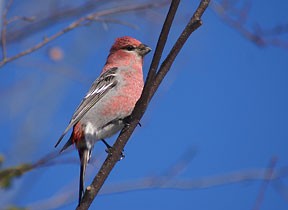Birders help Great Backyard Bird Count set records
More checklists submitted and more species identified than ever before made this year's Great Backyard Bird Count (GBBC) a banner year. The four-day event, Feb. 15-18, also revealed several bird species in places where they have never before been reported.
This year's GBBC, which is sponsored by the Cornell Lab of Ornithology and the National Audubon Society, received more than 85,700 checklists, surpassing last year's record by several thousand, with record identifications of 635 species. Volunteers also sent in thousands of stunning bird images from around the continent.
Due to the massive seed production failure in trees across northern Canada, a huge influx of northern finches came south looking for food. "As predicted, there were record numbers of GBBC reports for pine grosbeak," said Rob Fergus, senior scientist with the National Audubon Society. Common redpolls and evening grosbeaks also were reported at their highest levels in several years.
On the other hand, yellow-billed magpie numbers hit a new low. Magpies, crows and jays are especially susceptible to the West Nile virus. For the past few years the population of yellow-billed magpies has declined following the spread of the virus to California. Nationwide, American crow and blue jay numbers appear to have stabilized somewhat but need to be monitored as the populations of these birds continue to adapt to the presence of this new disease, according to Cornell ornithologists.
The GBBC also showed the explosive geographic expansion of Eurasian collared-doves. This species has spread aggressively since it was introduced in Florida in 1980. For the first time, GBBC had reports of this bird from British Columbia, Manitoba and Oregon.
Other species showed up in the GBBC for the first time, including a masked duck -- a bird usually seen in the tropics -- that was reported this year in Texas. And an Arctic loon, seldom seen outside Alaska, was spotted in California, while an ivory gull from the high Arctic showed up on a checklist in South Dakota.
"Each year, awareness of the GBBC seems to spread," said Cornell Lab of Ornithology Citizen Science Director Janis Dickinson. "Committed individuals, nature centers, parks and schools adopted the GBBC as their own in an unprecedented way this year. They held bird walks, ID workshops and many other events tied to the count." For example, preschoolers built feeders out of milk jugs. An artist painted a mural of urban birds in Hollywood. One participant commented, "Participating in the bird count has given my children a little taste of what it is like to be a scientist."
For a detailed summary of this year's results, visit the GBBC Web site at http://www.birdcount.org/, where maps, photos, prize-drawing winners and the cities and towns that topped their state or province for the number of checklists submitted are also available.
The Great Backyard Bird Count will return Feb. 13-16, 2009.
Media Contact
Get Cornell news delivered right to your inbox.
Subscribe